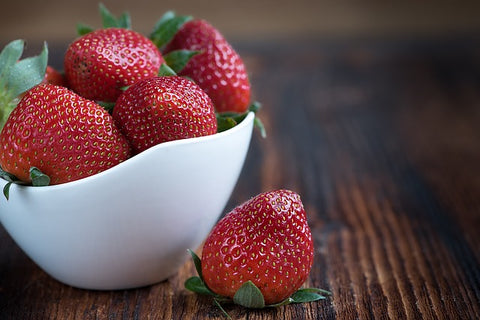Macronutrients: Carbohydrates
In this series of articles, we’re going to look at just what makes the body tick. There are six dietary components required by the body. You may already know the headlines, but I’m going to dig deeper and talk about what each of these are:
The Essential Six:
Macronutrients:
- Carbohydrate
- Protein
- Fat
- Vitamins
- Minerals
- Water
Macronutrients
These are nutrients the body requires primarily for energy. They’re called macronutrients because they need to be consumed in large amounts.
Micronutrients
These are nutrients the body requires in order to ensure proper metabolism, growth and development. They are termed micronutrients, as they need to be consumed in very small amounts.
In this article, we'll look at carbohydrates. Subsequent articles will focus on fats, protein and finally micronutrients.

Carbohydrates
The basic unit of a carbohydrate is a monosaccharide, which are more commonly found combined in units of two to form disaccharides:

The ratio of Glucose:Fructose in Sucrose (are you keeping up?) varies hugely depending on the source. For example, corn syrup is almost 100% Glucose, whereas agave syrup and fruit juice concentrates are up to 75% Fructose. Honey and sugar are about 50-50. This bit comes in with GI stuff. I know what you're going to ask me; which sugars are best? Well, the verdict is still out. There is some evidence to suggest that fructose is not as good as glucose, as it's metabolised mostly by the liver and can be converted into triglycerides (the main constituent of body fat). Equally though, as it is sweeter than glucose a lesser amount is required to achieve the same sweetness. Whatever the exact answer is, one thing is for sure: it all depends on when and how you take your sugar. Fruit is always better as it provides other beneficial nutrients.

Starch is a Polysaccharide (multiple units of Glucose), which is later broken down into single units, hence why eating high starch foods can have a similar effect to eating sugar. Cellulose is another Polysaccharide made of Glucose units, however due to the way the Glucose molecules are joined, cellulose is not readily absorbed or digested by the body. This is what forms dietary fibre which improves bowel movements, reduces blood sugar and keeps you feeling full. A study showed that adding 100g of fibre to the diet of men with high cholesterol reduced their total cholesterol by 13% and also reduced their bad cholesterol. So cellulose is a bit of a hero.
Good & Bad Carbohydrates
Carbohydrates are not all absorbed by the body at the same rate. The speed at which a carbohydrate is broken down and absorbed varies greatly and is termed the ‘Glycaemic Index’ or (GI). The higher the GI of a carbohydrate, the faster it raises blood sugar. This is why certain carbohydrates have been associated with diabetes and obesity. When a high GI carbohydrate is consumed, the blood sugar level rises quickly and in order to counter this, the body releases the hormone Insulin at a high rate. As it does so, the glucose is driven into the cells and blood sugar drops; Insulin follows suit. There are a few problems with this. First of all if the sugar that is delivered to the cells following consumption is not utilised immediately, then the body converts it into fat for storage. Secondly, the sharp rise and drop in blood sugar, is what’s responsible for that “high” and “low” feeling you get. This makes you feel hungry quickly. The third and most serious problem is that these spikes in Insulin levels have been linked to Type II Diabetes Mellitus and Metabolic Syndrome. So unless you’re taking on-board carbohydrate that your body is going to use immediately, it’s best to try and have low GI carbohydrates in your diet. Identifying high and low GI carbohydrates is difficult and there is certainly nothing that is provided on food packaging that would help. Learning which carbohydrates are better for you is something that you will pick up more and more as you improve your dietary intake. A good starting list is posted here by Harvard Medical School.
Glycogen: The Body’s Carbohydrate Store
Although Glucose is used by our cells to produce energy, it cannot be stored as single molecules, so if it not used immediately for energy, it is excreted by the kidneys. The solution is by connecting numerous molecules together to form the Polysaccharide, Glycogen. This can then be stored in the muscles and the liver (in a ratio of 4:1). When muscles have used up their instant anaerobic fuel (ATP-CP, which provides only a few seconds of energy), they start using glycogen. The total amount of Glycogen stored in the body, is about 2000Kcal, which is enough to fuel a 15-20 mile flat run and when Glycogen stores are depleted, you "hit the wall". When people talk about “carb loading” prior to races, it’s in order to ensure that Glycogen stores are replete and available; a bit like making sure you have a full petrol tank before a long drive. Once your glycogen stores are full, any excess sugar is converted to fat.
So ‘no carbs before Marbs’ isn’t necessarily the answer, but you should be thinking a little more about keeping your carbohydrate intake to those with a lower GI on a day-to-day basis.
This blog is written by friend of Neat, Dr Nick Ambatzis MB BS, MSc (SEM), MRCGP.
Nick is a General Practitioner specialising in Sports and Exercise Medicine. He completed his medical degree at University College London Medical School in 2002. Nick worked for almost ten years as a junior surgeon and spent three years in Trauma & Orthopaedics. He attained a Masters in Sports and Exercise Medicine and subsequently trained as a GP practising in Paddington.
From an early age, Nick has been both a keen cross-country runner and water-polo player, having competed at college level. Nick is also an accomplished ultra-marathon runner, having competed in many cross-country and cross-alpine races, ranging from 50-100 miles. He has also been a Crossfit and Crossfit Endurance coach.
